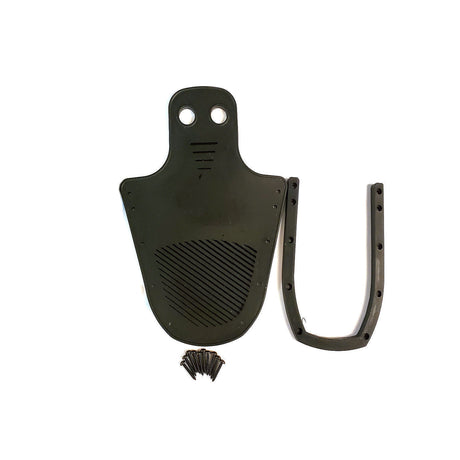We've covered some hydrofoil sports -- specifically wake foiling and foil surfing. But there's yet another way to enjoy hydrfoiling (shown above, with ski legend Tony Klarich performing some aerial tricks) and that's with a ski foil. What is it, and what's the difference between ski foiling and other hydrofoils? Let's break it down.
What is Ski Foiling?
A ski foil is exactly what it sounds like: A modified water ski, made to be shorter and wider than a typical water ski, with a hydroil wing and mast attached to its underside. Unlike other hydroils and water skis, ski foils are meant to sat upon. Directly atop the mast mount, on the topside of the ski, is a second mount for a seat.

Pictured: Sky Ski Pro SS Sit-Down Hydrofoil
The rider sits atop the seat, with both feet resting inside open toe plates mounted parallel at the front of the ski. This is where the original waterski hydrofoil -- the Air Chair -- gets its name from. These types of foils are also common called sit-down hydrofoils.
Ski Foil vs. Other Hydrofoils: What's The Difference?
Beside the obvious differences in riding styles -- all ski foils require the rider sit down, while other hydrofoils require the rider to stand -- the ski foil's physical components are noticeably different.
Ski foil wings are smaller.
The wings on a ski foil are narrower and taller than those found on wake foils and foil surfboards. They're also made from forged, polished aluminum. Other hydrofoil board wings are made almost exclusively from composites, like fiberglass and carbon fiber.
Ski foil boards are smaller, too.
When ski foils were first invented in the late 1960s, their boards were nothing more than regular waterskis bolted together, with a mast underneath.
Today, ski foil boards are made by design, forming what is effectively a significantly shorter slalom ski that's a big wider to accommodate the rider's front feet sitting parallel in the front toe plates.
Ski foil masts are taller.
Most hydrofoil masts are 12" to two feet tall. But ski foil masts are much taller, measuring around 3 feet. This places the rider higher above the water, affording a smoother ride in big wakes.
Ski Foil vs. Hydrofoils: What's The Same?
Beside the rider's stance, and the physical differences noted above, the ski foil is, fundamentally, no different than other hydrofoils.
You'll use the same tow rope.
Ski and sit-down foil riders still use the typical 60- to 75-foot wake rope and handle. Your placement in the wake behind the boat is the same as if you were riding a standard wake foil or foil surfboard.
You'll ride at the same speeds.
The speed required to get a sit-down hydrofoil up and moving is about the same as any other standing hydrofoil: Beginners can ride at 15 to 18 miles per hour, then dial up tow speeds to between 20 and 30 MPH, depending on skill and confidence.
Can You Ride a Ski Foil Standing?
Yes! But you'll need to make some basic modifications, like removing the bolt-on seat and replacing it with a foot strap. You'll also need to remove the front toe plates and install a front foot strap, or at least install some grip tape or foam padding.
Some ski foils even include the components required to convert the setup from a sit-down ride to a standing ride.
Because of the extra length of ski foil masts, getting up and moving can prove a bit of a challenge compared to starting out on other hydrofoils.
Is A Ski Foil Better Than Other Hydrofoils?
Ski foils might look more restrictive than wake foils and foil surfboards. but experienced ski foil riders can perform impressive tricks, and grab big air.
It's actually easier to perform flips and mid-air tricks on a ski foil, since the rider and foil are secured together with three points of contact.
Ski foiling can also make for an easier, more relaxed riding experience compared to other hydrofoils. Less energy and balance is required to ride a ski foil -- just get up and moving, and enjoy a leisurely sit-down ride.
(All ski foils require a tow)
Ski foil riding affords less freedom of movement than hydrofoiling. Since you're seated, you can't pump your legs up and down to generate your own lift and forward momentum, like you can on a wake foil or foil surfboard.
In other words, you'll need to rely on the tow rope and handle the entire time.
Which Hydrofoil is More Cost-Effective?
Ski foils cost about the same as other hydrofoil -- between $1,500 and $2,500 -- depending on the materials used to form the board, mast, and wing.
Check out all available hydrofoils here! We have sit-down foils, including the original Air Chair, and quality wake foils and foil surfboards for all riders.











